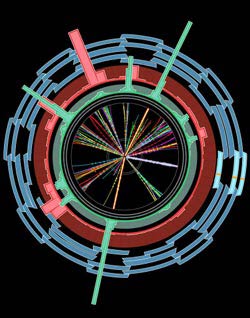Budding Black Holes

Tiny black holes could soon be made on demand in particle accelerators, but shortly after their birth, they might blink out of existence. In the 14 October PRL, a team proposes a mechanism for this vanishing act: The space around these black holes could wrap upon itself and bud off, forming a new baby universe that is invisible to us. Such an event might signify the existence of extra dimensions beyond the three we are familiar with and might give clues to the properties of the extra dimensions.
An astronomical black hole forms when enough matter is squashed into a small enough space to reach a critical density. According to theory, the same critical density could be reached if two particles slam violently together, creating a tiny black hole. Just how violent the collision must be depends on the number of dimensions in our universe. If there are only the three dimensions of space we’re familiar with, then making black holes would require particle energies far greater than any known process can produce. But if the Universe has extra dimensions, as quantum theories of gravity predict, then gravity could get much stronger at very short distances and suck the two colliding particles together once they get close enough. Black hole creation could then be within reach of CERN’s Large Hadron Collider (LHC), the new accelerator in Geneva due to start smashing protons in 2007.
In preparation for the LHC, theorists have been trying to predict the behavior of such tiny black holes. A 2002 paper suggested that soon after being created, a black hole could disappear into the extra dimensions [1] but no one has fully described this process.
Now Antonino Flachi and Takahiro Tanaka at Kyoto University in Japan have fleshed out the picture. In extra-dimensional theories, most particles would be trapped in our three-dimensional world, which physicists call the brane. But gravitons, the carriers of gravitational forces, can travel out of the brane and into the extra dimensions. If the brane were a flat, stretchy sheet, a black hole could emit a graviton perpendicular to the sheet, and the black hole’s recoil could distort the nearby brane region, creating a deep dimple.
To simulate the brane’s warping, Flachi and Tanaka used a computer to crunch through general relativity equations. In their simulations, the events following the dimple creation depended upon the properties the team assumed for the brane–properties that remain unknown. A “flexible” brane could close up around the dimple. This “brane bubble” could then pinch off from ours and break free, forming a so-called baby brane that is separate from and invisible to our own. With a “stiffer” brane, tiny black holes would remain visible to us. So black holes briefly appearing at the LHC could give hints about the properties of the brane and the extra dimensions, say Flachi and Tanaka.
Dejan Stojkovic of Case Western Reserve University in Cleveland says the new study confirms his earlier paper [1] suggesting that small black holes could leave our brane. However, Greg Landsberg of Brown University in Providence, Rhode Island, is skeptical about the broad applicability of the results. He says there are many scenarios that include different assumptions that result in black holes being trapped on the brane. Rather than spend a lot of time discussing various possibilities, he says, “I prefer to wait a few years until the LHC turns on.”
–Mason Inman
Mason Inman is a freelance science writer in San Francisco.
References
- V. Frolov and D. Stojkovic, “Black Hole as a Point Radiator and Recoil Effect on the Brane World,” Phys. Rev. Lett. 89, 151302 (2002)


